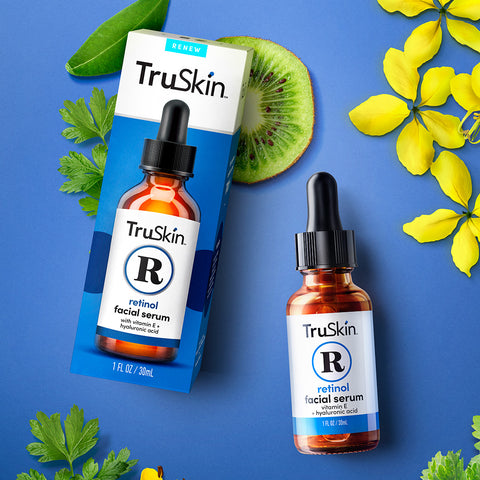
The Difference Between Inflammatory & NonInflammatory Acne
Because acne comes in many shapes and sizes and it’s important you know what you’re dealing with…
As the most common and widespread skin condition in the world, acne sure is a pain in the butt. According to the American Academy of Dermatology, it not only affects up to 50 million Americans every year but, as any woman going through menopausal acne right now, it can strike at any time.
Sigh.
The most problematic thing about acne is that it’s not a one-size-fits-all. There are all manner of medically termed types including acne mechanica, that pesky little business caused by friction and repeated pressure against the skin (hello ‘maskne’) and acne conglobata, a rare but very severe form that results in deep, interconnecting abscesses on the body.
However, the most common type that you know (and most definitely DO NOT love) is the mighty acne vulgaris.
But that’s not all, because acne vulgaris also comes in many different guises, each of which have their own ‘quirks’ shall we call them. They all fit into one of two camps, however – inflammatory and noninflammatory acne. And here’s what you need to know about dealing with both…
Noninflammatory Acne
Undoubtedly the lesser of the two evils, noninflammatory acne encompasses all the stuff that’s, well, not inflamed. We're talking the non-red, hot or super painful acne spots – namely blackheads and whiteheads.
Most commonly found on oily parts of the face like your nose, chin and forehead, as well as the chest and back, blackheads and whiteheads are known medically as comedones. They occur when an excess of sebum and dead skin cells get trapped in tiny hair follicles just below the surface of your skin, clogging your pores and forming tiny bumps.
The difference between blackheads and whiteheads – other than their color (dur!) – is that whiteheads remain closed at the surface of your skin, whereas blackheads are open at the surface so all those dead skin cells and sebum get exposed to the air. So what? Well, when this happens, they oxidize and darken. Public service announcement: blackheads are not dark because they’re clogged with dirt, they’re just full of oxidized skin cells and sebum. Yeah, we know that doesn’t make them sound much better, but still, it’s worth knowing.
Why do some people get blackheads and whiteheads while others don’t? Well, contrary to popular belief, they’re not caused by poor hygiene but, like all types of acne vulgaris, are exclusively down to overactive sebaceous glands. Genetics plays a major role in how much sebum your skin produces, but things like your hormones, skincare and haircare regime, medications and stress all have their part to play.
Inflammatory Acne
Unlike blackheads and whiteheads that, granted, are frustrating and unsightly but are relatively painless, inflammatory acne is where the big guns, aka bacteria get involved.
Inflammatory acne includes those pimples that have become inflamed thanks to bacteria mixing with dead skin cells and sebum. See, it’s not that complicated really! And by ‘inflamed’ we mean any kind of pimple that looks red, feels hot or sensitive to the touch, or is downright painful.
This type of pimple can be split into four different types:
1. Papules: the smallest and least angry of the pimple gang.
2. Pustules: the gross-looking ones that are filled with pus.
3. Nodules: large, hard, tender bumps that hurt like hell.
4. Cysts: even larger bumps that are filled with pus and look like boils.
The specific bacteria involved in inflammatory acne is called cutibacterium acne or c.acnes which is actually a very important component in your skin’s microbiome – a balanced group of microorganisms that reside on your skin to keep it balanced, healthy and protected from the outside world.
What makes c.acnes go awry and hence contribute to inflammatory acne is very complex and still not entirely understood, but all you need to know is this – over-sanitizing with harsh cleansers upsets the balance of our microbiome so, while it might be tempting don’t go down that road. Also, a cruddy diet and sluggish lifestyle are all said to contribute to an unbalanced microbiome so look after yourself and your skin should thank you – as least in part, anyway!
It's also worth noting that noninflammatory acne can turn into inflammatory acne if it’s left untreated. So, on that note…
Your Best Line Of Defense Against Inflammatory & Noninflammatory Acne
Severe acne should always be left to the professionals so if you have issues with seriously inflamed cysts and nodules (aka nodulcystic acne), seek treatment from a dermatologist quick smart to avoid potential scarring.
If, however, your breakouts are mild to moderate, there are many things you can do at home to help improve your acne.
1. Remove Surface Debris With Regular Exfoliation
Encouraging cell turnover is super important to stop all those dead skin cells from getting ‘stuck’ in your pores, and the most recommended course of action is some kind of salicylic acid treatment. Unlike facial scrubs which are great but can be irritating for acne-prone skin, salicylic acid works by dissolving the bonds between skin cells which helps them slough away quicker and easier. Salicylic acid also cuts through sebum and has anti-bacterial properties, so it’s a great choice for oily, problematic skin.
Try our Vitamin C Super Serum+ which combines salicylic acid with hydrating hyaluronic acid and niacinamide to help tackle redness and irritation.
2. Treat Breakouts With Tea Tree Oil
Hands down one of our favorite ingredients for acne-prone skin is tea tree oil. Sure benzoyl peroxide is great, but it can a) bleach your pillowcase and b) totally dry out your skin. Tea tree oil, on the other hand, is a natural, kinder alternative that’s anti-inflammatory and has antimicrobial properties to help kill unwanted bacteria. What’s not to love? Get your hands on our Tea Tree Super Cleanser+ to see for yourselves just what it can do.
3. Mix Up A Baking Soda Face Mask
Full disclosure: we’re not massive fans of using kitchen ingredients to treat your skin. Because there’s so much that can go wrong. However, a small teaspoon of baking soda, mixed with one or two tablespoons of warm water and applied to your skin for five to 10 minutes is a great way to help balance your skin’s pH levels and loosen blackheads and whiteheads.
Baking soda can be mildly irritating, however, so try this just once a month, never use more than a teaspoon and always follow with moisturizer like Vitamin C Brightening Moisturizer.
4. Try Some Overnight Retinol
Retinol is a master at helping to keep acne of all shapes and sizes under control because it boosts cellular turnover to promote healthier pores and a smoother complexion. It also gets right under your skin, stimulating collagen and elastin production to help strengthen your pores and reduce your chances of scarring.
We love that for you.
Try our Retinol Facial Serum two or three times a week before bed, and on off nights, apply Retinol Moisturizer. You could even layer them both if your skin tolerates retinol well. Not sure about using retinol for the first time? Then we always recommend patch testing it first, then introducing it slowly into your nighttime skincare routine.
5. Avoid Pore-Clogging Skincare & Makeup
Finally, and super importantly, avoid using anything on your skin that will congregate in your pores and therefore add to any build-up. Heavy, occlusive ingredients like paraffin, mineral oils, cocoa butter, beeswax and coconut oil are all major no-nos, but when in doubt, look for the term ‘non-comedogenic’ on your product labels which means it’s less likely to block your pores.
Also, harsh sulphates, parabens and drying alcohols should be given a wide berth as they can irritate your skin. And, as we’re sure you’re aware, inflammation and irritation is a terrible combination.















